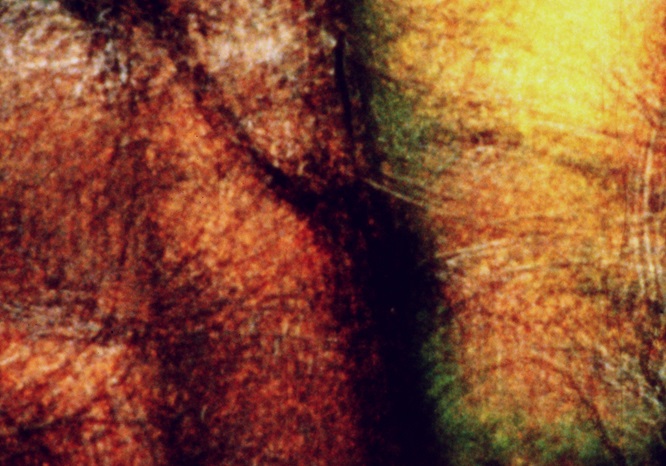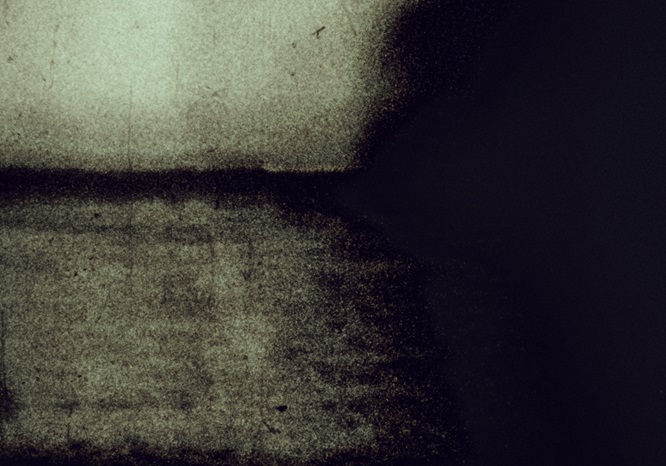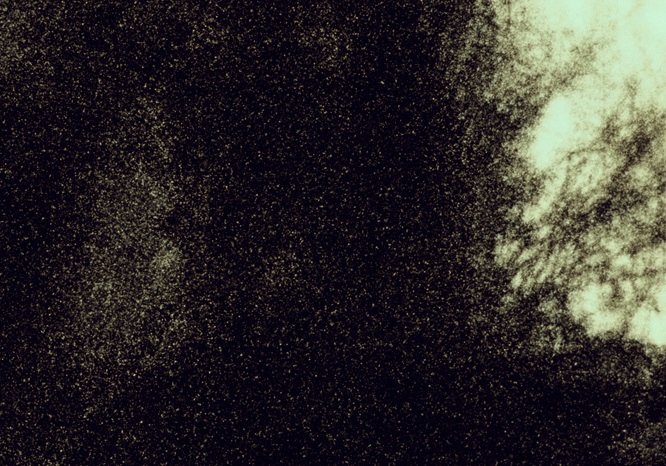

:: I. [Alexandre Larose]
Alexandre Larose is a Montreal-based film artist who completed a degree in mechanical engineering before switching streams and plunging into a BFA and MFA at Concordia University. Scientist and poet, his work is founded on one of the great pleasures of being a movie artist: The ability to see something again, to review actions a frame at a time, to dive into the mysteries of the too familiar. For seven years, he filmed a walk from his family’s cottage near Lac Saint-Charles, down a path carved out of trees and bushes, and finally, ending on a pier. He made nineteen films there in a series he named brouillard (2008-2015), each walk punctuated by stops and restarts as he wound the film back in the camera in order to produce a suite of overlaid impressions, as if he were stepping through time itself. For his Ville Marie series (2006-2017), he threw a variety of cameras over the roofs of a series of buildings before settling on the first skyscraper built in Montreal, Place Ville-Marie. When he found the building he wanted, he dreamed of work there as a janitor so he could live inside his experiments. Special housings were hand-built to ensure the cameras pointed skywards, and to keep them from smashing to pieces.
In his new series, scènes de ménage (I./II./III., 2017-2022), the artist steps back into the family home to film his father, Jacques Larose, a man he names “his figure”. In these films, Jacques performs familiar daily rituals which are filmed and refilmed, as the artist rewinds the film in his camera many times, creating a domestic symphony of overlays, variations on a theme. This first film in the series, scènes de ménage I., concentrates on the opening of a window that reveals a forested landscape. Glorious autumn colours fill the frame with warmth and light as the divisions between inside and out blur.
In scènes de ménage II., Larose’s father sits on a couch, or stands at a window. Soft eruptions of the natural world intervene, wide shots of the lake, or clouds or forest. But mostly, how comforting it is to see the small world most of us live inside, attended to with such care and meticulous attention. No need to reach for something grand in a faraway place, all the seeing the artist needs to do is right here at home, in a place made newly strange by layers of grain and scratches and processing marks. The act of crossing a room turns into an adventure of seeing, as the multiplied bodies shiver and swell, pulsing with an uncanny phantom light.
There is a dark cast throughout, as if the model, his father, is nearing the end of his days. His movements are slow and laborious, and his presence is phantom-like, as if he were already disappearing. I watched my own father leave the world slowly, over years, as he retreated from his body, losing most of the sensation in his feet, which made it hard for him to walk, and then in his core, which made getting out of chairs a challenge, and then impossible. Larose’s three silent meditations bear witness to a passage between worlds, as his father slowly dissolves into light.

:: II. [Alexandre Larose]
scènes de ménage III. focuses on his father’s gestures and movement. He turns before the window, pulls a drape open, walks the stairs, steps out into the lawn. Each action features a phantasmagoria of impressions, a breathtaking swirl of gathering bodies floating across the frame until he pauses, and, in this respite, the many bodies collect themselves, collapsing into a temporary unity, before he sets off again. These thrill ride cascades of sensation were created on a variety of film stocks, sometimes in a threatening tinted black-and-white heavy with grain, sometimes in a sun-drenched colour. Refusing to settle into one mode or another allows me to see the colour when it appears, and likewise to notice when the image is black-and-white. It serves as a reminder that even within the same short film, habits of seeing can render parts of the movie invisible. And as the film progresses, it works hard to undo one of my most steadfast habits, to centre whatever is human, and relegate the rest to the background, as lifeless props that support the human figure. Here, Larose very softly brings figure and ground together in a drenched visual stuttering that offers a glimpse of a world that has not been colonized or converted into property and ownership. The stars are curtain, chair and drape. It is at last an ecological vision, where everything is alive and in relation, interdependent.
All three films are silent. An unpopular choice, to say the least. Even the silent era of the movies, in the early moments of the XXth century, was not silent. There was always a piano in the house, or else a man declaiming loudly as the pictures rolled, guiding attentions. But when artists began making movies, they ushered in the radical possibility of silent films, though I can’t help recalling the famous John Cage experiment in 1951. Hoping to experience silence, he visited Harvard which had constructed a baffled room that was perfectly silent. A few minutes after settling in, he noticed the almost there sound of a running stream, along with a faint drumbeat. What he was hearing was his own blood running, and the rhythm of his heart. He concluded that silence was both impossible and indispensable.
I’ve sat so often in the silent theatres of the fringe, where audiences small and large shuffle uncomfortably, waiting for the imposed quietude to end. Without a soundtrack, it felt like we were being returned to our unwanted bodies, as if we had come to the cinema to escape that burden. In a culture where pictures of the body bloom from every direction, where advertisers understand that any manufactured object, no matter how pointless or absurd, looks more like hope if a beautiful body stands by it, smiling at it, pointing at it, perhaps it’s no surprise that our bodies are part of an unwanted life, one that is increasingly designed to avoid them. What is the computer but the latest evolution in this trajectory? To insist on silence, as Larose does, means cutting against some of the deepest grooves in the culture. For most people, a silent film is not simply unendurable, it is a hostile act, a provocation.

:: III. [Alexandre Larose]
Let’s listen to the artist weigh in about the act of seeing. His words come from a wonderful interview with Tess Takahashi.
I need to make a conscious effort to see something for what it really is. It’s a bit like being in a relationship that initially seems to be conditioned by unconscious psychological expectations. This can last for a while until you start to realize what the person is actually like. I think a lot of couples break up then. But, at that point, there can be a nice switch, where you’re like: “Okay, this is the person.” This happened with my father, for instance. I’ve started to know him as another human being. I think it’s the same thing with any relationship, any object, any thing in the real world. Basically, with attentive recognition, preconceptions aren’t determining what is seen. [1]
I think he’s telling me that, when he sees something, he sees only the past, the habits, the old grooves. It reminds me what my friend Gary said about guitar improvisation, that his hands are like dogs, returning to familiar places over and again. In order to see something new, outside the echo chamber of past perceptions, we need to work. Seeing isn’t simply available with the flick of an eyelash, but a steep task that requires considerable effort. It seems likely then that Larose would embrace someone he’s known his whole life, in order to try to see him for the first time, as someone entirely Other and unknown. These sustained bouts of attention are a slow-moving gift of time, returning us to our bodies, filled with wonder that the familiar might appear again as silent prayer.
[1] Tess L. Takahashi, “Q & A: Alexandre Larose,” desistfilm, Sept. 2, 2015 (https://desistfilm.com/q-a-alexandre-larose/)
*
Mike Hoolboom began making movies in 1980. Making as practice, a daily application. Ongoing remixology. Since 2000 there has been a steady drip of found footage bio docs. The animating question of community: how can I help you? Interviews with media artists for 3 decades. Monographs and books, written, edited, co-edited. Local ecologies. Volunteerism. Opening the door.
 |
envoyer par courriel | 
| imprimer | Tweet |
